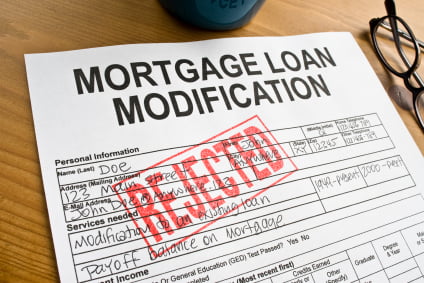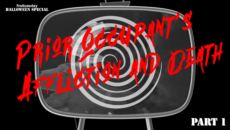This article covers efficacy of mortgage modifications and why lenders are hesitant to grant them.
The Great Recession hit the housing market of California harder than all states, except Nevada and Florida. Job loss and declining home values created a negative equity issue for nearly 30% of California’s homeowners — 2,500,000 who bought or refinanced a home after 2001. For them, foreclosures have become a plague.
To most, it makes little rational sense to continue paying on a black hole asset when one can rent a comparable house for half or less than the payment on the homeowner’s mortgage. However, a staff report from the Federal Reserve Bank of New York (The Fed) indicates many homeowners are trying to stay in their properties, and are seeking payment modification plans to do so.
Lenders, on the other hand, are not willing to do the type of mortgage modifications necessary to keep homeowners solvent and in their homes. Rather, they grant interest rate modifications without a principal reduction, which have done very little to help underwater homeowners stay afloat. Lenders, in consciously parallel step, refuse to do principal cramdown mortgage modifications — and no one, except Congress, is in a position to do anything about it. With so many interest rate modifications re-defaulting, lenders will eventually take most of these properties by foreclosure. They will then resell them for less than a cramdown loan amount. So, a puzzle exists: why are lenders refusing principal cramdown modifications? [For more information regarding the negative equity problem, see the September 2010 first tuesday article, The LTV tipping point: when negative equity owners are most likely to strategically default.]
Consider the homeowner who lost his job, but recently found employment. He’s still living in his negative equity home with a loan-to-value (LTV) of 117%. However, after months of living off unemployment benefits, he is also several months delinquent on his mortgage. Now that the newly-employed homeowner has a positive income flow, he plans to ask his lender for a mortgage modification, hoping his lender will help him out of his debt-to-income (DTI) payment problem as well as his insolvency, both driven exclusively by his home’s negative equity.
Unfortunately for the homeowner, the lender’s interests and homeowner’s interests differ greatly since they are inherently adversarial, with each side focusing on their own financial needs — solvency. The homeowner wants to stay in his house, but he doesn’t want the added burden of paying for years just to eliminate the negative equity in his home created by the 20% to 25% excess mortgage amount. (To be solvent, the homeowner needs a 90% to 94% LTV).
For the lender, mortgage modifications are rather expensive to process, since so many of them re-default and end in foreclosure. Even with mortgage modifications in which the payments were reduced, 57% re-defaulted in the first year during 2009. Thus, lenders are stingy with offering mortgage modifications. For lenders’ purposes, delinquent homeowners who have a negative equity condition and are interested in a mortgage modification fall into three categories:
- borrowers who will cure their delinquency and bring their loan current without a modification;
- borrowers who will be unable to cure their delinquency even if a modification is arranged; and
- borrowers who will cure their delinquency with a mortgage modification.
The fear of losing money by approving a mortgage modification for a homeowner in the first two categories keeps lenders from offering mortgages to people who need them, those in the last category. That fear in application maximizes lender profits, at the expense of the delinquent homeowners who, if given the opportunity of a mortgage modification, would be able to save their homes.
Interest-rate reductions: Putting a band-aid on a gaping wound
Imagine the lender gave our recently-employed homeowner a mortgage modification since he is not one of California’s typical negative equity homeowners with an LTV exceeding 125%, which bars them from modifications. Generally, the lender lowers the homeowner’s monthly mortgage payments by reducing the interest rates on the loan for a period of time, essentially converting the loan into a hybrid/rollover ARM. It is standard under the government’s Home Affordable Mortgage Program (HAMP) to lower the mortgage payments to a 0.31 DTI; 31% of the homeowner’s monthly income.
The lender typically also extends the life of the loan to further ease the burden of the monthly mortgage payments. Using HAMP guidelines as an example, the lender can decrease the loan’s interest rate to as low as 2% for five years and extend the loan term up to 40 years. Interest rate modifications are intended to provide the homeowner with a temporary respite from the overwhelming cost of homeownership, while not damaging the lender’s book value for the loan. However, interest rate reduction-only modifications do not solve the underlying problem of the homeowner’s negative equity — solvency. [For more information regarding HAMP, see the April 2010 first tuesday article, New HAMP revisions: mortgage relief plan 2.0.]
Principal balance cramdowns: Stitching the wound to heal
The least popular modification option among lenders (and thus Congress) is the principal cramdown arrangement. A principal cramdown lowers the homeowner’s principal mortgage balance to reflect the current value of the home it encumbers, a value fast becoming a permanent pricing condition in the market for the immediate future. To be effective, principal cramdowns need to be applied to underwater homeowners with a loan-to-value (LTV) ratio of 115% or more and reduce the principal balance to between 90-94% LTV.
Lenders must learn and quickly begin to understand the present and foreseeable status of prices in the housing market, coupled with the fully predictable continuing rise in the rate of delinquencies through 2013, will cause lenders to lose money (lots of money) on these underwater homes. These losses happen in every recession — and this one has the added stress of the worst financial crisis for the US banking system since 1933. The larger the loan amount and the higher the LTV ratio, the more likely the homeowner is to default and the larger the loss for the lender. California mortgage lenders are headed towards massive losses and no one — government or public — seems much concerned.
Of the hundreds of thousands of modified mortgages compiled for the Fed’s mortgage modification report, roughly 66% of the loan modifications produced a reduced monthly payment. 19% of modifications actually resulted in a higher monthly payment. It is common for the homeowner to be brought current by adding past due payments to the principal balance, called a capitalization modification, necessary for the cash-starved homeowner and a likely reason for the higher or stationary monthly payments.
Only 5% of mortgages modified resulted in a lower principal balance — the hated cramdown — while 64% of modifications produced a higher principal balance worsening the homeowner’s negative equity — the personal solvency issue. 70% of the modifications resulted in a lowered interest rate. This suggests that lenders are willing to work with homeowner when lenders have a zero interest rate cost environment as they now do — thanks to the Fed — but are unwilling to absorb any loss of their invested principal.
Lenders are convinced principal reductions for a few will create a moral risk causing homeowners who would otherwise make their mortgage payments to default so they too get a loan reduction. As lenders delay foreclosures and are allowed to drag out the cleanup of their bad mortgage portfolios for years, negative-equity homeowners are themselves becoming better informed. They are also getting better anti-deficiency protection for past refinancing from the California state legislature, and have started to jump on the strategic-default bandwagon. The past general consensus that one should pay their mortgage debts, regardless of whether doing so is rational, has come unanchored, and it will take lenders a long time to reestablish public thinking about mortgage obligations. [For more information about anti-deficiency protection, see the November 2010 first tuesday Legislative Watch, Anti-deficiency bars first trust deed recovery on short sales of one to four residential units.]
The form and magnitude of the modifications affect the likelihood of re-defaulting. The larger the reduction of monthly payments, the less likely the homeowner is to re-default. Additionally, the likelihood of a re-default is greatly reduced if the homeowner’s loan payments build up equity though principal amortization. Luckily, these two factors are not mutually exclusive; they are single-handedly accomplished by a cramdown of the mortgage balance without any interest rate reduction or reamortization. So why do lenders more frequently employ a mortgage modification method, the interest rate reduction, with a higher probability of re-defaulting?
Brokers and agents need to get a lot less friendly with lenders
Lenders aren’t bothering with public policy considerations that homeowners, fearing the financial obligations of homeownership, may very well become permanent tenants upon leaving their upside down homeownership. Foreclosure is a stressful process, and leaves wiped-out homeowners apprehensive, if not dejected, about taking on that kind of responsibility again.
Intuitively, homeowners losing their homes to foreclosure will simply rent an equivalent home instead (and do so for a lot less money per month). Mobility of the labor force to go where the jobs are is the national policy that gave American economic prowess its strength, and the inability of negative equity homeowners to sell and relocate to those jobs is not of concern to lenders. Welcome to housing and the immobile labors in Spain and Ireland with over 80% homeownership (and no tax incentives to get it there).
Of the nearly 230,000 notices of default (NODs) recorded in California during the first three quarters of 2010, approximately half have or will end up sold at a trustee’s sale. By not working out foreclosure alternatives for those 115,000 displaced homeowners, lenders are creating great trepidation and uneasiness associated with homeownership. These conditions will limit the number of homes sold and with them the loans made in the future — not a good trend for the multiple listing service (MLS) environment or mortgage loan brokers (MLBs). [For more information regarding NODs in California, see the first tuesday Market Chart, NODs and Trustee’s Deeds: Grim signs of real estate’s present condition.]
Unlike policy makers and families, lenders have no sufficient collective corporate brainpower to consider looking forward to building a future in a community. Lenders are here today, place bets tonight, gone tomorrow — all courtesy of the Federal Deposit Insurance Corporation (FDIC), as well as voluntary mergers and acquisitions. [For more information on NODs and NOTS, see the first tuesday Market chart, NODs and Trustee’s Deeds: Grim signs of real estate’s present condition.]




















Nice site, I envy it, but it seems a little weird when under mozzila browser, keep it moving:)
I just cant stop reading this. Its so cool, so full of information that I just didnt know. Im glad to see that people are actually writing about this issue in such a smart way, showing us all different sides to it. Youre a great blogger. Please keep it up. I cant wait to read whats next.
I have been working through the loan mod process with WAMU/Chase since Nov. 2009. They just granted me a trail loan payment with very little information. However, the amount I am currently paying versus the amount I would be paying is about $800 less per month which is great. The other thing the trial paperwork said was, “There are no monetary incentives for timely payments under this program. However, you will be offered principal forgiveness as part of the final modification, which could have tax consequences. You should check with your tax advisor on how this affects your situation.”
I checked with my relationship manager and he had never seen the document but said that 1.5 weeks ago they were talking about starting to do principal reductions. He said he was suprised that it happened so quickly.
So it appears that the banks are finally starting to figure this thing out. I will have to wait for three months to see what principal reduction I am offered.
The people now gladly submitting “full docs” hoping to get loan modifications are the very same people who only went “stated income” when they applied for the loan. So in addition to creating a disastrous new “custom” or expectation for future lending, the approval of modifications can be construed as an admission the bank’s prior underwriting accepted liar’s loans without question.
And banks are bound to get a bunch of “fairness” litigation from the ACLU (or whoever) about which cram-downs they approved or didn’t approve, and why some minority or another didn’t get theirs approved.
And no good deed goes unpunished: A bank “cram-down” gives them a tax deduction they will have to justify to the IRS, which might not allow it (for some reason or another). And then the repayment of principal on the modified loan becomes taxable income for the bank. So why hassle? A foreclosure gives immediate full tax write off, and the money can be relent without a cloud hanging over the bank’s reserves.
How in the hell does a home owner with a verifiable hardship and DTI of 31% get a loan modification? The lender must be making more money through the foreclosure while being backed by the insurer. Such was the case of One West Bank. This is how owner gets had and us, the general taxpaying public, also gets had, as we are the ultimate ones that back the insurer like FDIC. This makes one loose all respect of lenders as well as our so called government, who created this mess in the first place.
Is there any leverage that this type of home owner can use to get their loan modification? Please let me know, so that I can help them.
Please allow me to add that making lenders the villain is easy, and largely deserved. I work with homeowners everyday who are trying deal with disorganized, redundant, and impotent loss mitigation departments. Many of my clients have received HAMP and other modifications, and most are very satisfied with the change, though all are totally fed up.
A very difficult consideration in principal balance reductions (“cramdowns” if you must) is the fairness factor. If a homeowner lost equity, then sharing the loss makes sense. If the homeowner put zero down, then a principal reduction is a painless windfall, and I can appreciate a lender’s reluctance.
I can also appreciate the Congress members who get elected by many homeowners who are neither underwater, nor very happy about paying the government to pay the lenders to pay the people who had no business getting a loan in the first place. It doesn’t help to know that the securities traders, loan brokers, and everybody on the gravy train in between during the past decade could bank their profits — or spend them — and slip virtually unnoticed into the “who me?” woodwork.
The primary reason for principal reductions is to salvage the residential real estate market and to rescue it from the notorious and catastrophic “shadow inventory.” Everybody who owns a house benefits — lenders, mortgage investors, homeowners with equity and those without — and neighborhoods, communities, businesses, the construction industry … well just about everybody.
Of course, this isn’t happening, but it’s where our attention should be focused. As real estate professionals, we know that to close it you’ve got to sell it. Nobody buys when they’re forced.
For more about me and my opinions, check mortgagebriefing.com.
“Cramdown” is a catchy phrase that expresses the frustration and helplessness of a lot of underwater homeowners. If you’re trying to impress lenders and influence decision-makers, however, it’s pejorative and condescending. Principal balance “reduction” is accurate and less emotional, and keeps the conversation, though one-sided, on a more objective and useful level. That’s just my opinion for whatever it’s worth.